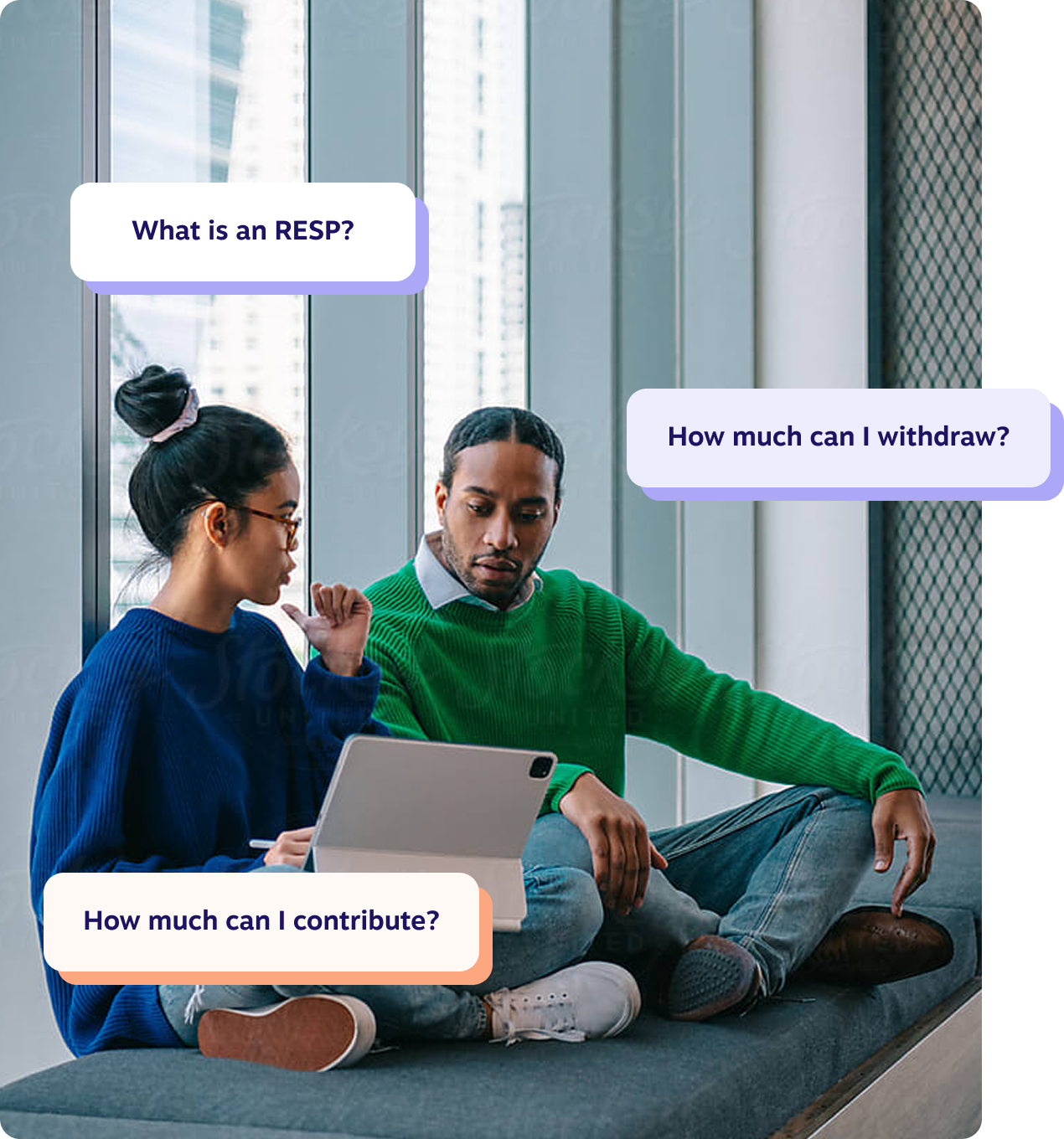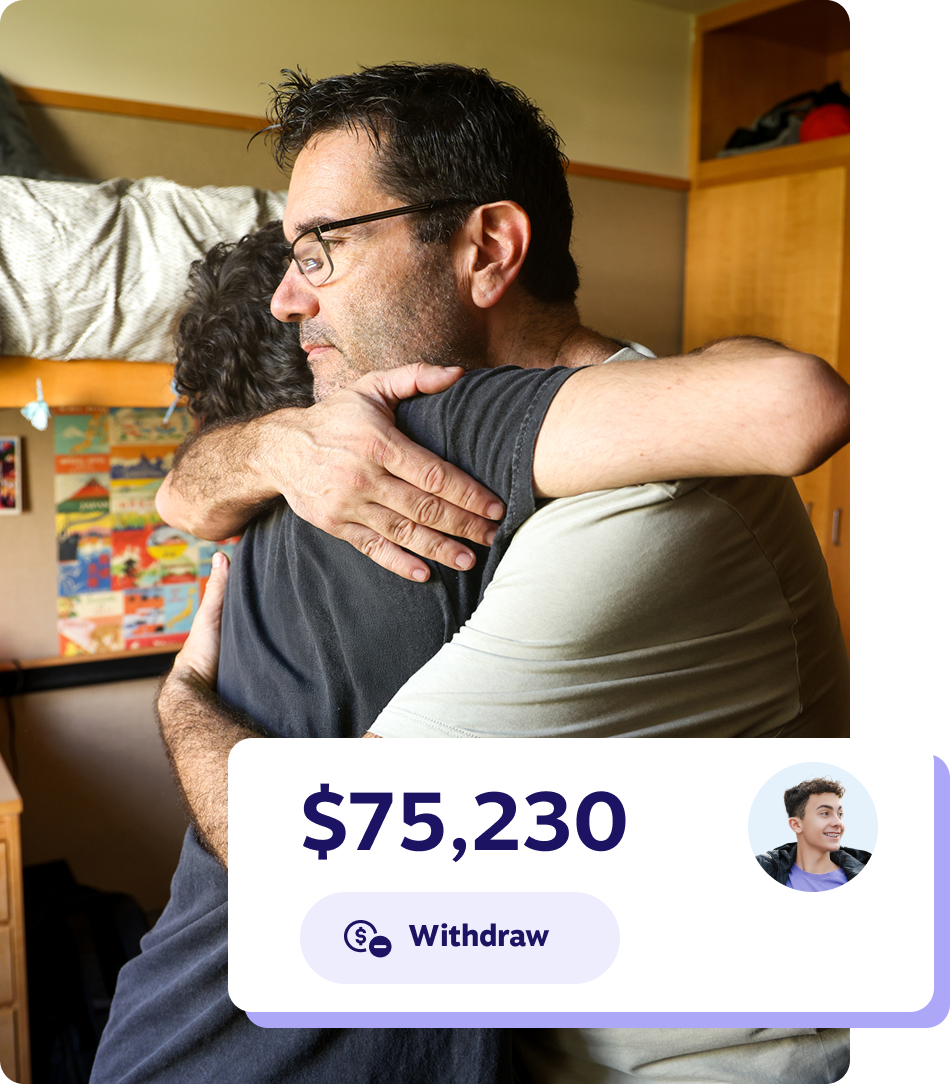What is a Registered Education Savings Plan (RESP)?

Table of Contents
What is an RESP?
An RESP (Registered Education Savings Plan) is an investment account that helps you save for a child’s post-secondary education—and their future. In addition to the money you invest, the Canadian government also contributes funds in the form of grants to help your investment in the future. Your RESP grows tax-free until the funds are withdrawn. Since many students have little or no other income, they can usually withdraw money from the RESP tax-free.
Find out why an RESP is the best way to save for your post-secondary education journey.
What’s the Difference Between a Family Plan and an Individual Plan?
Family RESP plans
Family RESP plans can be opened for one or more children under the age of 21 who are related by blood or adoption.
The contributions you make to the RESP are designated to each child in the plan in order for them to attract their own earnings and government grants — but the earnings can be shared among the children (up to $7,200 for the Canada Education Savings Grant). This means that if one child does not attend post-secondary education, or if they do not need all of the funds saved, the remaining funds can be used by the other children.
Individual RESP plans
Individual RESP plans can be opened for a single child by anyone (including an aunt, uncle, friend, godparent, self) who wishes to invest in a child’s post-secondary education—the subscriber does not need to be related to the child.
This plan is best suited for a subscriber who is not a parent, grandparent or sibling of the child; for an adult (18-21) who wishes to save for their own post-secondary education; or for a child who is over the age of 21.
How Does an RESP Work?
Thinking about investing in the future can be a bit overwhelming, but starting an RESP is pretty straightforward—and we’re here to help you along the way. We’ve summarized the process into three easy to steps:
1. Set Up Your RESP Account
It takes about ten minutes to set up your RESP once you have all your information handy. You, and each child you’re saving for, must have a valid social insurance number (SIN). You’ll also need a government-issued ID such as a driver’s license for yourself, and personal information for you and your child(ren).
Apply for a SIN if you don’t already have one.
2. Contribute and Grow Your RESP
Once you’ve set up your account, take some time to figure out what you can afford and how often you can contribute to your RESP. If you’re not sure how much you can afford, remember that we’re here to help you create a plan that works for you and your family.
With the combination of your contributions, government grants and investment income, you’ll be able to see your RESP fund grow as your child(ren) gets closer to graduating high school.
3. Use Your RESP Funds
When it’s time for your student to head off to college or university, simply withdraw what you need from your RESP when you need it. We can help you withdraw the smart way, keeping tax rates and your student’s needs in mind.
How to Maximize Government Grants?
Several grants provided by the government match your RESP contributions to maximize your savings and offer support to families with modest incomes. Making the most of these grants is a great strategy along your savings journey. We’re here to show you how.
Canada Education Savings Grant (CESG)
This grant is provided by the Canadian government and is the cornerstone of contribution matching. The government matches 20% of your contributions up to maximum grant amounts of $500/year and $7,200 over the lifespan of your RESP. Once you’ve set up your Embark Student Plan, we’ll automatically apply for this grant on your behalf.
If you started late or previously contributed less than $2,500/year, you can carry forward those missed amounts to current or future years. Read more about the CESG and carry forward room.
Additional CESG
Lower and middle-income families may qualify for a slightly modified version of the CESG, which provides an extra 10% or 20% in grants to the first $500 of annual contributions each year. Here’s a helpful overview.
See how grants can add up to support your child’s education
| Net Family Income | $55,867 or less | More than $55,867 to $111,733 | Over $111,733 |
|---|---|---|---|
CESG – Paid on first $2500 on annual contribution | 20% = $500 | 20% = $500 | 20% = $500 |
ACESG – Paid on first $500 on annual contribution | 20% = $100 | 10% = $50 | 0% = $0 |
Canada Learning Bond (CLB)
For families with modest incomes, the CLB is based on net family income and the number of children in a family. This bond provides a one-time initial grant payment of $500. From there, the government will automatically add $100 to your RESP for each year of eligibility until the child is 15-years old. That could mean as much as $2,000 in additional government grants. We can help you learn more about this.
Special requirements for 18-20 year olds
This age group may still be eligible to receive the CLB and get up to $2,000 into an RESP. The amount received depends on the number of years they were eligible to receive the CLB before turning 15. We can help you learn more about this.
How the Canada Learning Bond is Calculated
| Number of children | Adjusted net family income for the 2022-2023 year |
|---|---|
1 to 3 | $50,197 |
4 | $56,636 |
5 | $63,101 |
We will ensure you get all the grants you’re entitled to.
When and How Much Should I Save?
With the average post-secondary education costing roughly $90,000, students need more help than ever saving for their future. Today, the average family only saves $15,000 for the post-secondary education journey. And, while 92% of parents think an education is important, only 50% have RESPs.
So, how much do you need to save and when should you start?
There’s no one size fits all approach to financial planning. Whether you start saving the moment your child is born or when they start school, the important thing is to take the leap and get started. Even if you start small and contribute as often as your budget allows, your savings will grow and over time you’ll be on a stable path towards their education—and their future.
More questions?
What are the Rules for an RESP?
While setting up, contributing to, and withdrawing from your RESP is straightforward, there are certain rules you need to keep in mind. Knowing what they are—and that we’re here to help you with them—will make following them straightforward as well. For example, knowing your contribution limits, what’s considered a qualified post-secondary education or training program and how to withdraw funds without penalty will help to make sure you get the most of your RESP.
Saving for the Future has Never Been Easier
Maximize Your Government Grants—Automatically
Did you know the government offers up to $12,800 per child in education savings grants? At Embark, we make sure you get every dollar you’re eligible for—without the hassle.
We handle everything for you.
Government grants are our specialty. Open and contribute to an Embark registered education savings plan (RESP) to:
1. Automatically apply for all eligible grants on your behalf
2. Ensure you receive the maximum amount based on your contributions and eligibility
Let us handle all the paperwork, so you don’t have to That means more free money for your child’s education—without the stress.
How Much Can You Get?
Depending on your income and contributions, your child could receive:
- Canada education savings grant (CESG) – Up to $7,200 per child
- Canada learning bond (CLB) – Up to $2,000 for eligible families
- Provincial grants – Additional funds in select provinces
That’s up to $12,800 in free government money helping to grow your RESP.
Start earning free money today!
With automated grant applications, expert management, and flexible contributions, saving for your child’s education has never been easier.
Get started now and make the most of your RESP.
Invest With Confidence in Your Child’s Future
Our best-in-class registered education savings plan (RESP) is designed to help your savings grow early while keeping them safe as your child gets closer to post-secondary education. With our expertly managed investment strategy, you can maximize growth potential in the early years and reduce risk as school approaches – so you can plan for their future with confidence.
The Glidepath Advantage - A Smarter Way to Invest in Education
Our glidepath advantage ensures that your RESP investment mix automatically adjusts over time to balance growth and security.
- Early years: When your child is young, we focus on higher-growth investments to help build your savings.
- Middle years: As your child gets closer to high school, we gradually shift to a more balanced mix of growth and stability.
- Final years: As post-secondary approaches, we prioritize protecting your savings by moving into lower-risk investments.
With glidepath advantage, you don’t have to worry about making investment decisions – we do the work for you, so you can stay focused on your child’s future.
Your Investment Mix Changes as Your Child Grows
Our age-based investment strategy ensures that your RESP adapts over time. Here’s how your investment mix evolves:
- Early growth: More exposure to equities for higher potential returns.
- Balanced approach: A mix of equities and fixed income to manage risk.
- Capital preservation: Emphasis on secure, lower-risk investments as school nears.
| Age of child | Target Fixed Income Allocation 2024 | Target Equity Allocation 2024 |
|---|---|---|
0-2 | 10.0% | 90.0% |
3-5 | 17.5% | 82.5% |
6-8 | 25.0% | 75.0% |
9-11 | 38.5% | 61.5% |
12-14 | 55.0% | 45.0% |
15-17 | 72.5% | 27.5% |
18+ | 90% | 10% |
This strategic approach helps optimize returns while reducing uncertainty as you get closer to using your RESP funds.
For more details on our investment strategy and fund performance, download our fund facts.
Flexible Contributions That Fit Your Budget
Whether it’s every month or once a year, you set the schedule that works for you. With flexible contribution options, you can invest in your registered education savings plan (RESP) in a way that fits your finances – making it easier to save for your child’s future.
Easy Ways to Contribute to Your RESP
Saving for education should be simple. That’s why we offer multiple ways to invest in your RESP:
1. Link a bank account
Connect your bank account in your Embark digital account and set up contributions on your terms:
- One-time contribution – Add funds whenever it works for you.
- Recurring contribution – Set up automatic contributions to stay on track with your savings goals.
2. Make a bill payment
- Prefer to contribute directly from your bank? You can set up your Embark RESP as a payee in your online banking bill payments.
3. Transfer in an existing RESP
- Already have an RESP elsewhere? It’s easy to transfer your RESP to Embark and take advantage of our expert investment strategy and low fees.
Contact us to learn more about transferring your RESP.
Start Saving Today!
No matter how or when you choose to contribute, every dollar saved brings your child closer to their education goals. Get started today with the option that works best for you.
